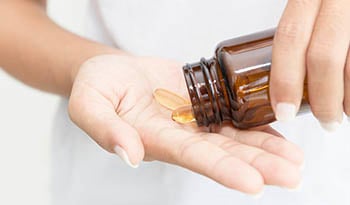DIM (Diindolylmethane) Supplements: Benefits, Foods, and Women’s Health
DISCLAIMER:This blog does not intend to provide diagnosis...
- In this article:
- What Is DIM?
- Hormonal Imbalance and Women’s Health Issues
- Food Sources of DIM
- DIM Research and Evidence
- DIM Side Effects
- How to Incorporate DIM Into Your Daily Routine

Maya Angelou’s delightful and transcendent poem “Phenomenal Woman” has always been one of my favorites. It is an ode of empowerment to women. And as I think about the poem at different points in my life, it reflects various aspects of the journey.
Life as a woman encompasses a broad spectrum of experiences, with a central commonality around the phases of health. A woman’s health crescendos and decrescendos, with different phases, bring different health concerns.
The reproductive system adapts to environmental changes, aging, genetics, and hormones. Hormone imbalances can bring menstrual irregularities or polycystic ovarian syndrome. Estrogen imbalance can lead to weight gain, difficulty losing weight, and an increased risk of breast cancer. And for many women, menopause brings hot flashes, night sweats, mood swings, and irritability.
This article discusses everything you need to know about DIM—what it is, how to get more of it, and what the research says about its effectiveness for different women’s health issues. First, let’s dive into an overview of common hormone-related women’s health issues.
What Is DIM?
Diindolylmethane, also known as DIM, is a biologically active plant constituent derived mainly from the cruciferous vegetable family. Research suggests cruciferous vegetables like broccoli, cauliflower, kale, and Brussels sprouts offer many health benefits, including anti-inflammatory, hormone-detoxifying, and liver-supportive effects.11-14
DIM is generated when a cruciferous vegetable is cooked or crushed. During this physical crushing or cooking, the compound myrosinase is activated and converts other compounds in the plant, known as glucosinolates, into indole-3-carbinol. When you eat crushed or cooked veggies, the acid in your stomach converts indole-3-carbinol to DIM.12
DIM impacts health in a variety of ways, including modulating estrogen receptors as well as a receptor associated with detoxification.14 DIM works as an anti-inflammatory agent by activating different signaling pathways. It also demonstrates anti-fibrotic, anti-oxidant, antiandrogenic, and immune-modulating properties.15-16 DIM also affects estrogen metabolism by modulating hormone detoxification pathways.17
DIM can support women’s health throughout different stages of life. In the sea of options for women’s health support, DIM stands out as a potent phytochemical that may help with estrogen imbalances and detoxification issues.
Hormonal Imbalance and Women’s Health Issues
Hormonal imbalances are an underlying theme for many common women’s health issues. Imbalances in cortisol, estrogen, progesterone, testosterone, and blood sugar hormones can initiate and drive disease states.
Menstrual cycle irregularities are often due to imbalances in the hypothalamic-pituitary-adrenal axis, which can be thought of as the control center for hormone production.1 However, estrogen and progesterone imbalances caused by lifestyle and environmental factors can also affect the menstrual cycle. Polycystic ovarian syndrome also often includes imbalances in blood sugar hormones like insulin.2
Due to the nature of hormone production and breakdown, hormone imbalance issues are often multifactorial. Hormones like estrogen and progesterone rely on different organ systems for proper breakdown and elimination. Gastrointestinal and liver issues may interfere with estrogen metabolism. Hormone imbalance, and specifically estrogen imbalance, is a key feature of many women’s health issues due to the many facets involved in regulating and metabolizing estrogen.
Estrogen Dysregulation
While estrogen, a hormone produced primarily in the ovaries, is a reproductive hormone, its functions extend well beyond the reproductive system. Estrogen receptors are located in the bone, brain, colon, liver, skin, and salivary glands.3
As women reach the fifth decade of life, we experience a natural decline in estrogen associated with menopause.4 However, many women experience estrogen dysregulation or estrogen dominance at some point in their lives when estrogen is too high or not properly metabolized. Estrogen dominance and dysregulation have been associated with PMS syndromes, endometriosis, fibroids, polycystic ovarian syndrome, and breast cancer.5-8
Overproduction or poor estrogen metabolism can lead to higher circulating levels, poor clearance, and overstimulation of estrogen-sensitive tissues. Xenoestrogens, environmental compounds that can mimic estrogen and stimulate estrogen receptors throughout the body, are another source of estrogen exposure.9 Xenoestrogens can be natural or synthetic. Synthetic xenoestrogens are commonly found in plastics, preservatives, and pesticides sprayed onto foods, while natural xenoestrogens are found in plants and fungi.10
Menopausal Symptoms
As women approach their fifth decade, menopause may be on the horizon. Menopause is characterized by a shift in hormone production secondary to the loss of ovarian function.4 Estrogen and progesterone levels begin to decline, which is associated with a myriad of symptoms.
Estrogen decline during menopause is associated with increased cardiovascular risks, dermatological issues, bone loss, irritability, night sweats, sexual dysfunction, migraines, and hot flashes.4 While menopause does not cause cancer, it is associated with an increased risk of breast cancer related to the age of onset of menopause due to changes in hormones like estrogen.20 Therapeutic agents, including hormone replacement therapy and botanical medicines, may help provide relief during menopause.
Food Sources of DIM
Cruciferous plants are a potent family of sulfurous vegetables rich in vitamin A, vitamin C, copper, folic acid, selenium, and zinc. Glucosinolates, the sulfur-containing molecules, are the most widely studied cruciferous molecule. DIM is a metabolite, or breakdown product, of glucosinolates.
Heating, chewing, crushing, and digesting cruciferous vegetables increases their DIM content. In one study, boiling cabbage increased its DIM content by six times.14
The liver contains the highest concentration of DIM in the human body—which is interesting given DIM’s impact on cytochrome detoxification systems. The kidneys, lungs, heart, and brain also contain relatively high levels of DIM. DIM is typically cleared from the body within 20 to 24 hours after consumption.14
A well-balanced, vegetable-rich diet is essential for optimizing health. Aim to incorporate proteins, healthy fats, vegetables, and fruits while reducing or eliminating processed and ultra-processed foods. Be sure to include plenty of vegetables from various plant families. This diversity supports a diverse gut microbiome that can support women’s health in many ways.25
While there are no specific guidelines for how many cruciferous vegetables you should consume daily, know that some people should increase their intake, while others may need to minimize their intake. Consult a registered dietitian for an individualized recommendation that’s right for you.
DIM Research and Evidence
Research on the impacts of plant constituents on human health and disease represents a new frontier in medicine. Cruciferous vegetables have been extensively studied in cell, animal, and human models primarily for their sulfur compounds. Evidence suggests DIM may have many uses, from detoxification upregulation to helping decrease risk and slow the progression of chronic disease.11-19
Estrogen metabolism is a complex process. Many factors can impact the body's ability to properly eliminate estrogens and estrogen metabolites like 16-alpha-hydroxyestrone (an unfavorable product of estrogen metabolism) as well as 2-hydroxyestrone and 2-hydroxyestradiol (more protective estrogen metabolites). The 2-hydroxyestrone to 16-alpha-hydroxyestrone ratio is used clinically as a biomarker for estrogen-related cancer risk.17
DIM may help with estrogen dominance and conditions such as endometriosis. In a randomized controlled trial examining the effects of DIM for endometriosis, DIM enhanced the standard treatment's effects and improved bleeding patterns.21,22 There is also a growing interest in its use for other estrogen-related women’s health issues, such as fibroids.23
DIM Side Effects
People who take hormone medications or have hormone-related cancers should talk with their doctor before taking DIM. Side effects of DIM can include gastrointestinal upset like nausea. One study reported urine darkening in people supplemented with DIM.26
How to Incorporate DIM Into Your Daily Routine
If you’re looking to incorporate DIM into your daily routine, start by increasing your intake of cruciferous vegetables. Cruciferous vegetables are a rich source of DIM, with Brussels sprouts, collard greens, cauliflower, broccoli, and kale containing some of the highest amounts.14 You may also supplement with nutraceuticals that contain DIM. Talk with your doctor about what dosage is clinically appropriate and safe for you.
Overall, DIM may be helpful for women dealing with hormonal issues and may help decrease chronic disease. Eating more cruciferous vegetables is a practical—and delicious—way to get more DIM. Also, ask your healthcare provider whether supplementing with DIM is right for you.
References:
- Bae, J., Park, S., & Kwon, J. W. (2018). Factors associated with menstrual cycle irregularity and menopause. BMC women's health, 18(1), 36.
- Marshall, J. C., & Dunaif, A. (2012). Should all women with PCOS be treated for insulin resistance?. Fertility and sterility, 97(1), 18–22.
- Eyster KM. The Estrogen Receptors: An Overview from Different Perspectives. Methods Mol Biol. 2016;1366:1-10. doi: 10.1007/978-1-4939-3127-9_1. PMID: 26585122.
- Peacock K, Ketvertis KM. Menopause. [Updated 2022 Aug 11]. In: StatPearls [Internet]. Treasure Island (FL): StatPearls Publishing; 2023 Jan-.
- Borahay, M. A., Asoglu, M. R., Mas, A., Adam, S., Kilic, G. S., & Al-Hendy, A. (2017). Estrogen Receptors and Signaling in Fibroids: Role in Pathobiology and Therapeutic Implications. Reproductive sciences (Thousand Oaks, Calif.), 24(9), 1235–1244.
- Chantalat E, Valera MC, Vaysse C, Noirrit E, Rusidze M, Weyl A, Vergriete K, Buscail E, Lluel P, Fontaine C, Arnal JF, Lenfant F. Estrogen Receptors and Endometriosis. Int J Mol Sci. 2020 Apr 17;21(8):2815.
- Noviyanti NI, Gusriani, Ruqaiyah, Mappaware NA, Ahmad M. The effect of estrogen hormone on premenstrual syndrome (PMS) occurrences in teenage girls at Pesantren Darul Arqam Makassar. Gac Sanit. 2021;35 Suppl 2:S571-S575. doi: 10.1016/j.gaceta.2021.10.103. PMID: 34929904.
- Bhardwaj, P., Au, C. C., Benito-Martin, A., Ladumor, H., Oshchepkova, S., Moges, R., & Brown, K. A. (2019). Estrogens and breast cancer: Mechanisms involved in obesity-related development, growth and progression. The Journal of steroid biochemistry and molecular biology, 189, 161–170.
- Paterni, I., Granchi, C., & Minutolo, F. (2017). Risks and benefits related to alimentary exposure to xenoestrogens. Critical reviews in food science and nutrition, 57(16), 3384–3404.
- David W. Singleton, Sohaib A. Khan. Xenoestrogen exposure and mechanisms of endocrine disruption. Front. Biosci. (Landmark Ed) 2003, 8(6), 110–118.
- Zhang X, Shu XO, Xiang YB, Yang G, Li H, Gao J, Cai H, Gao YT, Zheng W. Cruciferous vegetable consumption is associated with a reduced risk of total and cardiovascular disease mortality. Am J Clin Nutr. 2011 Jul;94(1):240-6.
- Tucci P, Brown I, Bewick GS, Pertwee RG, Marini P. The Plant Derived 3-3'-Diindolylmethane (DIM) Behaves as CB2Receptor Agonist in Prostate Cancer Cellular Models. Int J Mol Sci. 2023 Feb 11;24(4):3620.
- Ağagündüz, D., Şahin, T. Ö., Yılmaz, B., Ekenci, K. D., Duyar Özer, Ş., & Capasso, R. (2022). Cruciferous Vegetables and Their Bioactive Metabolites: from Prevention to Novel Therapies of Colorectal Cancer. Evidence-based complementary and alternative medicine : eCAM, 2022, 1534083.
- Thomson, C. A., Ho, E., & Strom, M. B. (2016). Chemopreventive properties of 3,3'-diindolylmethane in breast cancer: evidence from experimental and human studies. Nutrition reviews, 74(7), 432–443.
- Wang SQ, Cheng LS, Liu Y, Wang JY, Jiang W. Indole-3-Carbinol (I3C) and its Major Derivatives: Their Pharmacokinetics and Important Roles in Hepatic Protection. Curr Drug Metab. 2016;17(4):401-9.
- Le HT, Schaldach CM, Firestone GL, Bjeldanes LF. Plant-derived 3,3'-Diindolylmethane is a strong androgen antagonist in human prostate cancer cells. J Biol Chem. 2003 Jun 6;278(23):21136-45.
- Lord RS, Bongiovanni B, Bralley JA. Estrogen metabolism and the diet-cancer connection: rationale for assessing the ratio of urinary hydroxylated estrogen metabolites. Altern Med Rev. 2002 Apr;7(2):112-29.
- Dalessandri KM, Firestone GL, Fitch MD, Bradlow HL, Bjeldanes LF. Pilot study: effect of 3,3'-diindolylmethane supplements on urinary hormone metabolites in postmenopausal women with a history of early-stage breast cancer. Nutr Cancer. 2004;50(2):161-7.
- Vermillion Maier, M. L., Siddens, L. K., Uesugi, S. L., Choi, J., Leonard, S. W., Pennington, J. M., Tilton, S. C., Smith, J. N., Ho, E., Chow, H. H. S., Nguyen, B. D., Kolluri, S. K., & Williams, D. E. (2021). 3,3'-Diindolylmethane Exhibits Significant Metabolism after Oral Dosing in Humans. Drug metabolism and disposition: the biological fate of chemicals, 49(8), 694–705.
- Surakasula, A., Nagarjunapu, G. C., & Raghavaiah, K. V. (2014). A comparative study of pre- and post-menopausal breast cancer: Risk factors, presentation, characteristics and management. Journal of research in pharmacy practice, 3(1), 12–18.
- Morales-Prieto DM, Herrmann J, Osterwald H, Kochhar PS, Schleussner E, Markert UR, Oettel M. Comparison of dienogest effects upon 3,3'-diindolylmethane supplementation in models of endometriosis and clinical cases. Reprod Biol. 2018 Sep;18(3):252-258.
- García-Ibañez P, Yepes-Molina L, Ruiz-Alcaraz AJ, Martínez-Esparza M, Moreno DA, Carvajal M, García-Peñarrubia P. Brassica Bioactives Could Ameliorate the Chronic Inflammatory Condition of Endometriosis. Int J Mol Sci. 2020 Dec 10;21(24):9397.
- Borahay, M. A., Asoglu, M. R., Mas, A., Adam, S., Kilic, G. S., & Al-Hendy, A. (2017). Estrogen Receptors and Signaling in Fibroids: Role in Pathobiology and Therapeutic Implications. Reproductive sciences (Thousand Oaks, Calif.), 24(9), 1235–1244.
- Yerushalmi R, Bargil S, Ber Y, Ozlavo R, Sivan T, Rapson Y, Pomerantz A, Tsoref D, Sharon E, Caspi O, Grubsrein A, Margel D. 3,3-Diindolylmethane (DIM): a nutritional intervention and its impact on breast density in healthy BRCA carriers. A prospective clinical trial. Carcinogenesis. 2020 Oct 15;41(10):1395-1401.
- Siddiqui R, Makhlouf Z, Alharbi AM, Alfahemi H, Khan NA. The Gut Microbiome and Female Health. Biology (Basel). 2022 Nov 21;11(11):1683.
- Castañon, A., Tristram, A., Mesher, D., Powell, N., Beer, H., Ashman, S., Rieck, G., Fielder, H., Fiander, A., & Sasieni, P. (2012). Effect of diindolylmethane supplementation on low-grade cervical cytological abnormalities: double-blind, randomised, controlled trial. British journal of cancer, 106(1), 45–52.

 By Dr. Asia Muhammad, N.D.
By Dr. Asia Muhammad, N.D.


